You may have heard that in the last several years our university has been featured in the Princeton Review for our efforts and planning moving forward with campus sustainability.
The fancy light bulbs, huge silver steam-tower that overlooks campus and the fact that we have periods of a tray-less cafeteria are all tied in to this effort. Upon first examination, it may look like a cute public relations tactic, which is exactly what this staff had first thought when starting this week’s editorial, but this plan is a very deep one.
Picking on a plan that points to its end date as 2050 could be very easy. This campus will hopefully look a lot different in 39 years. Progress is a good thing, but with new buildings and an increased student population, monitoring our environmental footprint is a great, but challenging, idea.
One of the first steps on campus was to replace every bulb in the light posts to LED technology. This saves an energy equivalent of keeping 36 cars off the road for 10 years. This looks like the work of a university focused on their public relations output, which it might be, but they needed to show off something that has visible results.
If you find your way to the CCSU website you can search for ‘sustainability’ and download the ‘Climate Action Plan’. The 42-page document is filled with a plethora of introductions of what the campus has done to become more aware of their impact on the environment. This is a lot of self-adoration and back-patting. This includes the energy center, recycling and the reduction of water waste in the cafeteria and Devil’s Den.
For as quick and simple as these changes have been, excluding the energy center, they have successfully opened up the topic of campus sustainability to this university.
The systems that we are implementing now will shape the future of CCSU. Complex water monitoring systems in each building will help reduce waste. These are not standard at most universities and can help prevent vast amounts of waste from dorms and academic buildings.
As with most state schools CCSU will always find it hard to replace equipment and facilities that Connecticut has funded. In the plan there is a realization on our end that we should be constantly focused on replacing old and inefficient boilers, heating systems, windows and temperature controls. These simple steps are more preventative, but they will lower strain on our environment in time.
The biggest section of this plan comes under the subhead ‘Student Commuting.’ When you consider that according to the university 82 percent of students live in the surrounding towns and not on campus, this is a big issue. It’s been decided that the area will receive a bump in public transportation. This will help keep cars off the road. The university will also offer incentives to students who carpool. It’s a good idea, but might be a little impractical.
The only solution that will certainly help would be to add living space on campus. Our dorms are full and a shift to a more housing-based school bodes much better for the environment. CCSU, with their fancy water-monitoring system and promotion of recycling, can take a few thousand extra students under their wing and mold them into sustainable individuals. That might, just might, be President Miller’s dream.
2050 is a long way away. It seems ridiculous to make a plan that revolves around that date, but the plan is solid. It doesn’t forget to focus on logical long-term efforts but still keeps the present in mind. Our staff went into this week thinking that we could find a problem or holes in the ‘Climate Action Plan,’ but we could not. This plan has a chance to succeed, but it’s going to take some cooperation from the current faculty, staff and student body to make the future plans work. Let’s try and do that now before we can’t get out of our own carbon footprint.


